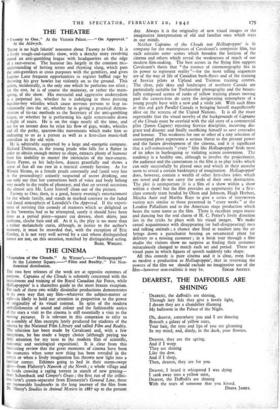THE CINEMA
"Captains of the Clouds." At Warner's. Hellzapoppin'" At the Leicester Square.—" Film and Reality." For Non- theatrical distribution.
THE two best releases of the week are at opposite extremes of purpose. Captains of the Clouds is solemnly concerned with the recruitment and training of the Royal Canadian Air Force, while Hellzapoppin' is a shameless guide to the most brazen escapism. Yet each of these two wildly dissimilar productions demonstrates in its own way that any film—whatever the subject-matter or style—is likely to hold our attention in proportion to the power or originality of its visual content. In spite of the modern embellishments of sound and colour and the fashionable antics of the stars a visit to the cinema is still essentially a visit to the moving pictures. It is relevant in this connexion to refer to an assembly of film excerpts lately produced for students of the cinema by the National Film Library and called Film and Reality. The selection has been made by Cavalcanti and, with a few exceptions, he has made a happy choice (although paying too little attention for my taste to the modern film of scientific, economic and sociological exposition). It is clear from this fascinating review that the great moments of cinema have been the moments when some new thing has been revealed in the screen or when a lively imagination has thrown new light into a familiar corner. Eskimos going to bed in their storm-swept igloo—from Flaherty's Nanook of the North ; a whole village and its herds crossing a raging torrent in search of new grazing— from Schoedsack and Cooper's Grass ; the first run of the collec- tive farm's cream-separator from Eisenstein's General Line, these are memorable landmarks in the long journey of the film from Dr. :Avers Studies in Animal Motion in 1887 up to the present , THEATRE day. Always it is the originality of new visual images or the
imaginative interpretation of old and familiar ones which stays in our minds.
. Neither Captains of the Clouds nor Hellzapoppin' is fit company for the masterpieces of Cavalcanti's composite film, but each contains some scenes which broaden the horizon of the cinema and others which reveal the weaknesses of much of our modern film-making. The best scenes in the flying film support Cavalcanti's thesis that " the essence of cinematography lies in its power to represent reality "—for the most telling sequences are of the way of life of Canadian bush-flyers and of the training of Service pilots at Upland and Trenton training centres. The clear, pale sides and landscapes of northern Canada are particularly, suitable for Technicolor photography and the beauti- fully composed scenes of ranks of yellow training planes moving past the camera-lens do carry the invigorating atmosphere of a young people busy with a new and a virile job. With such films as this and 49th Parallel Canada is bringing herself magnificently alive on the screens of the United Nations. It is all the more regrettable that the visual novelty of the backgrounds of Captains of the Clouds must be overlaid with the old story of a commercial pilot (James Cagney) rejecting Service discipline, incurring dis- grace and disaster and finally sacrificing himself to save comrades and honour. This weakness for one or other of a tiny selection of stereotyped plots represents a serious threat to the present power and the future development of the cinema, and it is significant that a self-consciously " crazy " film like Hellzapoppin' finds most of its jokes in burlesquing or violating screen convention. The tendency is a healthy one, although to involve the projectionist, the audience and the cameraman in the film is to play tricks which can only successfully be played once and which in their anarchy seem to reveal a certain bankruptcy of imagination. Hellzapoppin' does, however, contain a wealth of other first-class jokes which are novel and do-not carry the seeds of their own destruction. The plot is unimportant (it is a film of a show within a show within a show) but the film provides an opportunity for a first- class comedy team headed by Olsen and Johnson, Hugh Herbert, Mischa Auer and Martha Raye to give a series of interwoven variety acts similar to those presented in " crazy weeks " at the London Palladium and to the American stage production which bears the same name as the film. There is excellent negro music and dancing but the real charm of H. C. Potter's lively direction lies in the tricks he plays with his visual images. We make casual acquaintance with disappearing (or half-disappearing) men and talking animals ; a chance shot fired at random into the air brings down a parachutist beating an ornamental plant for delivery to a missing customer ; in a brisk tour through a film studio the visitors show no surprise at finding their costumes miraculously changed to match each set and period. There are visual puns in which figures of speech suddenly take shape. All this comedy is pure cinema and it is clear, even from so modest a production as Hellzapoppin', that in reviewing the powers of the film we should exclude no imaginative use of the film—however non-realistic it may be. EDGAR ANSTEY.


























 Previous page
Previous page